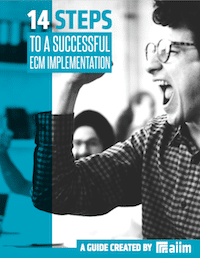The AIIM Blog
Keep your finger on the pulse of Intelligent Information Management with industry news, trends, and best practices.
Electronic Records Management (ERM) | Sharepoint and Office 365
Myth #1: It is too hard to implement “true” Records Management (RM) in SharePoint. Reality: Microsoft made SharePoint more of a retention tool with an interface that is familiar to SharePoint and IT professionals than an RM solution whose interface is familiar to RM professionals. “Out of the box” implementations of SharePoint RM require a wide variety of configuration settings, customizations, and choices that must be established and maintained by someone who is familiar with both SharePoint systems administration and retention policies. However, SharePoint add-on products are emerging that elegantly support the traditional principles and tenants of RM and enable the management of retention and disposition decisions based on information management policies in ways that are familiar to most RM professionals. These products fit into the familiar SharePoint user experience and enable enterprise RM with few of the penalties that some RM solutions have forced on SharePoint users, such as requiring users to understand multiple product interfaces and to search for information in multiple repositories.
Share
Awareness about electronic document management has increased over the last few years, but people are still not clear on many aspects of it. They often confuse it with file management, enterprise content management (of which document management is a subset), records management, etc. Here, we seek to bust five myths about document management, with a special focus on small businesses.
Share

Making an ECM implementation successful requires planning and attention to detail. The best way to create the right solution is to identify organizational goals and priorities. Learn how to manage a successful implementation in our free guide.
Enterprise Content Management (ECM) | Sharepoint and Office 365
We just completed our research to understand how businesses are using SharePoint to support their ECM requirements. The study uncovered some interesting insights. Here some the highlights.
Share
Enterprise Content Management (ECM)
1. Open-source still has a lot more potential. The open-source movement has gained significant momentum in the operating system and database market, as evidenced by the wide acceptance of Linux, Apache, PHP, and MySQL. This momentum has yet to have a significant impact on the open-source Web content management (WCM) and portal market. Although the number of Web content management open-source solutions available is large, the adoption rate remains low when compared to the market size.
Share
Batch Transaction Capture Software is used primarily to understand and extract data from documents in order to feed back-end database applications or business process analysis. It is designed to replace manual, error-prone, and expensive document sorting and data entry processes with automatic document classification, separation, and data extraction.
Share
Electronic Records Management (ERM)
There is something very wrong with how organizations manage information of business or legal value. Most ECM or ERM systems are not deployed across an enterprise; they are usually implemented in large and regulated industries to improve the control of information in a specific department or process. Why do so few business executives care about records management? The answer is complex, but here are a few thoughts.
Share